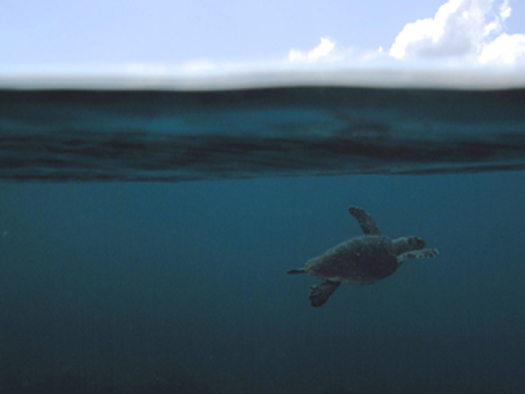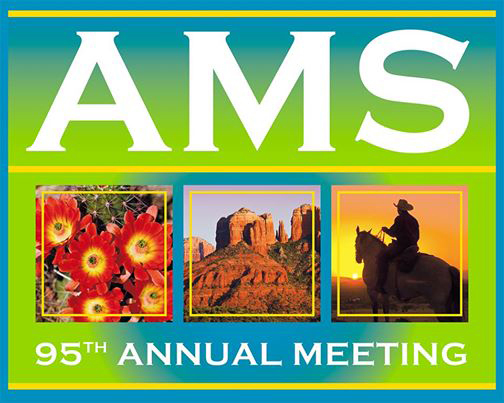Atmospheric Science Librarians International (ASLI) today celebrated their 10th year of honoring the best books in the fields of meteorology, climatology, and the atmospheric sciences at the ASLI Choice Book Award Ceremony at the Annual Meeting. Each year, ASLI chooses the best books based on nine criteria: uniqueness, comprehensiveness, usefulness, quality, authoritativeness, organization, illustrations/diagrams, competition, and references. 
The winner of the main award for 2014 was Oxygen: A Four Billion Year History, by Donald E. Canfield, published by Princeton University Press, which ASLI praised for being “a well-documented, accessible, and interesting history of this vital substance.” There were also awards given in two other categories. The winner of the History award was The History of Global Climate Governance, by Joyeeta Gupta, published by Cambridge University Press, for “bringing together a history and summary that readers are likely to reference often.” 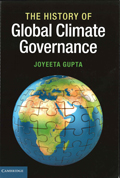 The top award in the Popular category went to Storm Surge: Hurricane Sandy, Our Changing Climate, and Extreme Weather of the Past and Future, by Adam Sobel, published by HarperWave, which was recognized by ASLI for “providing its readers with a detailed, clear understanding of the meteorological basis for Hurricane Sandy and the importance of our response to it.”
The top award in the Popular category went to Storm Surge: Hurricane Sandy, Our Changing Climate, and Extreme Weather of the Past and Future, by Adam Sobel, published by HarperWave, which was recognized by ASLI for “providing its readers with a detailed, clear understanding of the meteorological basis for Hurricane Sandy and the importance of our response to it.”
In the Science category, Honorable Mention awards were given to Dendroclimatic Studies: Tree Growth and Climate Change in Northern Forests, by Rosanne D’Arrigo, Nicole Davi, Gordon Jacoby, Rob Wilson, and Greg Wiles, and published by the American Geophysical Union, for “a clear summary of research from a renowned institution on this important topic”; and Air Quality Management: Canadian Perspectives on a Global Issue, edited by Eric Taylor and Ann McMillan, published by Springer Netherlands, for “bringing together expert views on many aspects of this topic from a Canadian perspective.” 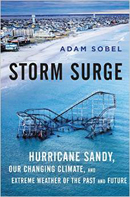 Honorable Mention in the History category was given to Tambora: The Eruption that Changed the World, by Gillen D’Arcy Wood, published by Princeton University Press, which ASLI described as “a book that makes this extreme event newly accessible through connecting literature, social history, and science.” And Honorable Mention in the Popular category was awarded to a title from AMS Books: Partly to Mostly Funny: The Ultimate Weather Joke Book, edited by Jon Malay with jokes from Norm Dvoskin, was praised by ASLI for being “a handy compilation of lighthearted humor about the weather and its place in our lives.”
Honorable Mention in the History category was given to Tambora: The Eruption that Changed the World, by Gillen D’Arcy Wood, published by Princeton University Press, which ASLI described as “a book that makes this extreme event newly accessible through connecting literature, social history, and science.” And Honorable Mention in the Popular category was awarded to a title from AMS Books: Partly to Mostly Funny: The Ultimate Weather Joke Book, edited by Jon Malay with jokes from Norm Dvoskin, was praised by ASLI for being “a handy compilation of lighthearted humor about the weather and its place in our lives.”
After you’re finished reading the best of 2014, be sure to let ASLI know what you liked in 2015 by sending them nominations for next year’s awards; you can get more information here.
Uncategorized
The Buzz Continues at #AMS2015!
For the 2015 AMS Annual Meeting, we’ve brought back The Buzz @ AMS, our “on the street” interviews with attendees. If you haven’t been to an AMS Annual Meeting before, these videos will help give you a perspective of what’s happening in the convention center. And if you’re here with us in Phoenix, maybe you’ll be the next one we talk to.
We hope you’ll check out our YouTube channel for the latest buzz from the meeting.
A Time for Geeks
Four episodes of The Weather Channel program “Weather Geeks” were taped in the Exhibit Hall yesterday, bringing large, enthusiastic crowds that made the Annual Meeting feel more like an ESPN College GameDay event. Some were even inspired to write haikus. Here’s a flavor of the action:
The Doctor is in! 15mins away… #AMS2015 pic.twitter.com/GWohS3lPCa
— WXGeeksTWC (@WXGeeksTWC) January 6, 2015
Its not quite College GameDay but handwritten signs made for the broadcast. I dont see any mascot heads either. #AMS2015
— Marcus Smith (@MRSmithSEWX) January 6, 2015
LOOK at the live crowd we have for @WXGeeksTWC! This is awesome. #AMS2015 pic.twitter.com/NDMWjzBkco
— Kathryn Prociv (@KathrynProciv) January 6, 2015
Watching @WXGeeksTWC taping at #AMS2015 with @kimklockow and @CommDocPA pic.twitter.com/NVMNwnpjlx
— Rick Smith (@ounwcm) January 6, 2015
@weatherchannel @wxgeekstwc haiku: Marshall Shepherd is the man. Giving the weather weenies voice on TV. It is amazing out there. #AMS2015
— Minh Phan (@WXMinh) January 6, 2015
@weatherchannel @WXGeeksTWC Send out the warning. Storms are on the horizon. The geeks are coming… #AMS2015 #WxHaiku
— Matthew Brown (@Rhapsodyinbrown) January 6, 2015
@hollylowry & I are so excited to be at a @WXGeeksTWC filming here at #AMS2015 ! Can't wait to watch in a few weeks! pic.twitter.com/KCFn9T0HTE
— Faith Eherts (@WxFaith) January 6, 2015
It's showtime! @WXGeeksTWC @DrShepherd2013 @CommDocPA #AMS2015 pic.twitter.com/oeKqyqqvht
— Amberrr (@Ambermometer) January 6, 2015
Geek scale turned up to 11 at the taping of WeatherGeeks. #AMS2015
— Chris Hattings (@wxgeekbeavis) January 6, 2015
.@KathrynProciv and I backstage for @WXGeeksTWC tapings at #AMS2015!! pic.twitter.com/YaIEuuNkbA
— Chrissy Warrilow (@AtlantaWxGirl) January 6, 2015
YES…THEY BROUGHT SIGNS RT @davidwkenny: #itsamazingotthere at #AMS2015 on @WXGeeksTWC @weatherchannel pic.twitter.com/ywh06JSBbr
— Sean Breslin (@Sean_Breslin) January 6, 2015
El presidente times two… Weather Geeks is taping now come check it out . #AMS2015 #wxgeeks pic.twitter.com/6nJywAYPw1
— Mike Chesterfield (@mchesterfield26) January 6, 2015
The people who made #AMS2015 @WXGeeksTWC possible and thank all of you for coming out. It's your show pic.twitter.com/jpuIW6nQGf
— Marshall Shepherd (@DrShepherd2013) January 7, 2015
Presidential Forum Drops the Puck on #AMS2015
Speakers at the Presidential Forum looked back, looked ahead, quoted Yogi Berra and Wayne Gretzky, and made attendees think about how far meteorology has come…and how far it could go in the future. Here are a few Twitter highlights:
#AMS2015, several thousand #weather and #climate professionals/stakeholders, presidential forum….let's go pic.twitter.com/FpscvsX9pn
— Marshall Shepherd (@DrShepherd2013) January 5, 2015
Inspiring to hear and see @kimklockow and @AstroKDS in the opening session of #AMS2015 as a female meteorology student.
— Kate-Lynn Walsh (@klwalshwx) January 5, 2015
Dr. Sullivan talking about technologies 25 years ago….1990….puts things in perspective as to how far tech has come so far #AMS2015
— Jared Rennie (@jjrennie) January 5, 2015
Dr. Sullivan quotes the great Yogi Berra – "Predictions are hard to make;especially about the future." #AMS2015
— Chris Hattings (@wxgeekbeavis) January 5, 2015
What will meteorology be like in 2040? We have a "living ensemble" of experts here to help predict it! #AMS2015
— Matthew Strauser (@pitpenguins87) January 5, 2015
Kathryn Sullivan NOAA administrator on 2040: personalized weather, rise of drones, biomimicry, sensor networks, science gaps, HPC #AMS2015
— Michael White (@MWClimateSci) January 5, 2015
Dr. Sullivan: We have to keep the human dimensions of technological change in focus. #AMS2015 #NOAA
— Keli Pirtle (@keliwx) January 5, 2015
as weather extremes increase, so will demand for weather information–water, food, energy nexus will be critical societal issue #AMS2015
— explomary (@explomary) January 5, 2015
.@noaa Administrator Kathy Sullivan quotes Gretzky in her thoughts about 2040 – we need to skate to where the puck is going to be #AMS2015
— Kathie Dello (@KathieDello) January 5, 2015
Sullivan: Customization and hyperlocalization are the future. #AMS2015
— Jason Elliott (@jsaysitall) January 5, 2015
Dr. Sullivan – find your learning sweet spot – Be just scared enough of new opportunities and take the risk #ams2015
— Andrea Melvin (@adm_wxed) January 5, 2015
"An absolute passion and fascination for the atmosphere and a drive to keep people safe" – @BernadetteWoods on why mets become mets #AMS2015
— Andrea Thompson (@AndreaTWeather) January 5, 2015
"Even if we bust the forecast, they come right back to us" – @BernadetteWoods on how public looks to mets for wx and climate info #AMS2015
— Andrea Thompson (@AndreaTWeather) January 5, 2015
Great reminder from panelist Curtis Walker. High impact weather events will still be with us, even if we're more tech advanced #AMS2015
— Alek Krautmann (@AlekKrautmann) January 5, 2015
In 2040, question raised: how will we tailor our enterprise to be the most useful to our end-users? Answer: you have to ask them. #AMS2015
— Deanna Hence (@deahence) January 5, 2015
One member of our living ensemble, @BernadetteWoods , predicts a 100% chance that meteorologists will still be needed in 2040. #AMS2015
— Matthew Strauser (@pitpenguins87) January 5, 2015
The Communication Continues on YouTube
New videos from the Annual Meeting in Phoenix continue to be posted on the AMS YouTube channel. So far you’ll find interviews with new AMS Fellow Jack Williams, on weather in the media; AMS Associate Executive Director William Hooke, on the state of the weather, water, and climate community; and UCAR President Tom Bogdan, on space weather science developments at the meeting this week.
More interviews with you and your colleagues, from poster sessions to hallway conversations, will be appearing on the channel throughout the meeting, so keep talking!
A Presidential Presence in Phoenix
At the Annual Meeting each year, past, current, and future AMS presidents come together. In Phoenix today, incoming AMS president Alexander “Sandy” MacDonald takes the reins from outgoing president Bill Gail.
“I hope to make the best use of my years of experience to bring the government, commercial, and academic communities together,” MacDonald comments. “I feel that my theme for next year’s meeting, ‘Earth System Science in Service to Society,’ weaves the many parts of AMS into a common core.”
For MacDonald, that experience is considerable: namely, 43 years at NOAA, with a diverse list of contributions to the science of weather and climate. One of them—his Science On a Sphere® —will be showcased at the kickoff of the meeting in Phoenix. The multimedia system displays full-color animated images of satellite, geophysical, and astronomical data on a sphere. It’s in more than 110 museums and science centers around the world and is now educating millions of people a year about many aspects of our planet.
MacDonald notes that “AMS is unique in bringing together the effort of understanding our Earth and the people who use that information to make life better.” (MacDonald’s career and plans as president are profiled in the upcoming January issue of BAMS.)
Following MacDonald in the leadership queue is Frederick Carr, who serves as AMS President Elect this year. Similarly to MacDonald, Carr’s plans as AMS president in 2016 include facilitating synergies and partnerships among all components of the atmospheric science community.
“I am honored and excited to be elected AMS President and look forward to helping the AMS provide leadership and support to the academic, public, and private sector members of the Society,” Carr says. “My current thinking is that the theme of the 2017 Annual Meeting will be ‘Observations Lead the Way,’ meaning that in all aspects of our related disciplines, from improving forecasts to making data-based policy decisions, obtaining and making best use of increased observational capabilities will best move our science forward.”
Fred has spent the past 37 years as a professor of meteorology at the University of Oklahoma, and served as the director of the School of Meteorology for 14 years (1996-2010) as the program doubled in size and moved into the National Weather Center. His expertise straddles both observational meteorology and numerical weather prediction. He takes pride in both having made significant improvements to NCEP’s numerical models in the 1980s and ‘90s and in the professional success of his students. He has served the AMS in many capacities, including as editor or associate editor of three AMS journals and as councilor (2001-04). He currently serves as cochair of the UCAR Community Advisory Committee for the National Centers for Environmental Prediction and on the UCAR Board of Trustees.
“I welcome all members of the AMS, from students to honorary members, to contact me if they have any suggestions for how the AMS can better serve them as we move forward to the 100th anniversary of AMS,” Carr notes. MacDonald echoes that sentiment, encouraging member input at the upcoming Annual Meeting as well as throughout the year as the Society’s Centennial approaches.
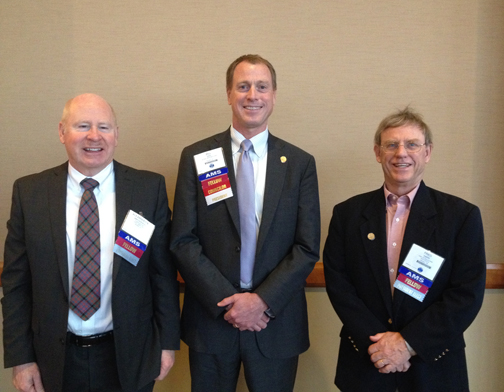
They're Not Pulling Punches in Phoenix
The 2015 AMS Student Conference must be off to a great start already. NOAA’s Deke Arndt already made a stir with a striking analogy about the relative meanings of weather and climate. Clearly the gloves are off and the discussion is moving fast. Now is the time to let your guard down and take in as much as you can!
Former OCS Assoc Climatologist Derek Arndt @DekeArndt talking Wx and Climate Hazards and impacts for AZ #AMS2015 pic.twitter.com/GanMffw5v6
— OK Climate Survey (@OKClimate) January 3, 2015
Weather throws the punches, Climate trains the boxer! #AMS2015 @AMSeducation pic.twitter.com/ssokGjcrxM
— Mr. Raeck (@MrRaeckSays) January 3, 2015
We can't predict if Rocky will win the 7th round, but we can tell if he may be more likely to throw more left hooks. @AMSeducation #AMS2015
— Mr. Raeck (@MrRaeckSays) January 3, 2015
Thinking–and Talking–about Climate Change and a New AMS Book
BAMS Editor-in-Chief Jeff Rosenfeld had the opportunity to talk with Bob Henson, author of the new AMS book, The Thinking Person’s Guide to Climate Change, at the 42nd Conference on Broadcast Meteorology in Olympic Valley, California, in June, where the book made its debut (you can watch the entire interview below). Originally known as The Rough Guide to Climate Change, this updated version is more comprehensive; according to Henson, it’s a one-stop shop for those looking for a little bit of everything regarding climate change. While there is plenty of fact-based science in the book, Henson also gives people ideas of what they can do on a practical level when it comes to combating climate change. When Rosenfeld asks if the thinking person will sleep better after reading the book, Henson’s answer is positive. He notes that while it’s a problematic issue, instead of simply worrying about it, we can all continue to understand it better in order to create the best possible future. Reading his book, which can be purchased online at the AMS Bookstore, is a great way to do just that.
The Annual Meeting Is Closer than You Think!
The 2015 AMS Annual Meeting in Phoenix is less than six months away. AMS President Bill Gail and 2015 Annual Meeting Organizing Committee chairs Andrea Bleistein, Andrew Molthan, and Wendy Schreiber-Abshire recently sent out this reminder that the deadline for submitting abstracts for the meeting is fast approaching:
Have you submitted your abstract for AMS 2015 yet?
Yes? Then you know that we’ve got something for everyone with over 30 conferences and symposia featuring almost 300 topics!
No? Don’t worry–there’s still time to submit your abstract before the deadline of 1 August!
This year’s theme is: Fulfilling the Vision of Weather, Water, and Climate Information for Every Need, Time, and Place
View the Call for Papers here: http://annual.ametsoc.org/2015/index.cfm/call-for-papers/
Submit your abstract online here: https://ams.confex.com/ams/95Annual/oasys.epl
Even if you don’t plan to present in Phoenix, we hope you make plans to join us in January. Check out our website to learn more about all the exciting things going on at AMS 2015!
We can’t wait to read your submission and look forward to your participation,
Bill Gail, AMS President
and
Andrea Bleistein, Andrew Molthan, and Wendy Schreiber-Abshire
2015 Annual Meeting Organizing Committee Chairpersons
Every Day Can Be World Oceans Day
by Anupa Asokan, AMS Education Program
Most of us recognize that the ocean is a driving force behind our weather and climate, but it is so much more than that. Comprising the majority of our planet, this environment was once thought to be limitless and infallible. While much of our hydrosphere remains to be explored, we’re quickly learning how vulnerable this chunk of our planet really is. Issues like ocean acidification and marine debris may pop up in our news feeds every now and then, but our daily activities have significant implications as to the health of this global ecosystem we rely upon for oxygen, food, transportation, and recreation, to name a few.
Working as a marine science educator in an outdoor setting, I was fortunate enough to share my love of this wonderful environment with children from all over the country. For many coming from inner-city schools or midwestern states, this snorkeling adventure would be their first and perhaps only encounter with the ocean. The goal in creating this positive ocean experience wasn’t just a cool story to tell mom and dad back home, but to instill a connection and sense of ownership for this fragile environment. At the AMS Education Program, we might not have the opportunity to put students first-hand into a kelp forest or coral reef, but we do provide teachers with the tools they need to bring the lessons these environments bear directly to the classroom. It seems odd to compare snorkeling through a kelp forest to teaching a teacher the fundamentals of oceanography, but the key here is awareness. Whatever the approach, ocean literacy can be a powerful a tool, because knowing is, after all, half the battle.
In a more global effort to encourage just that, World Oceans Day was born. Sunday, June 8th marked the 12th year of this worldwide ocean celebration. Like Earth Day every April, this annual event is intended to create awareness and hopefully encourage stewardship for the environment. This year, thousands of organizations in 70 countries arranged events to honor the ocean. From beach cleanups to film festivals to paddle-board races, there were opportunities to participate in just about every corner of the globe. For those without a local event, social media offered another avenue to join in with ocean selfies and photo contests. Many events even extend through the entire month of June, and you may also find regularly scheduled events occurring throughout the year. Even if you don’t live near water, there are some simple things we can all do to celebrate and protect the ocean year-round:
- Pick up trash and use less plastic
- Make responsible seafood choices
- Watch what you put down your drain
- Join or volunteer with a conservation organization
As a SCUBA diver, avid snorkeler, and lover of all things ocean, I’ve spent a lot of time enjoying everything that it has to offer. Whether you share my passion or are terrified of the deep blue, live near a coast or are landlocked, none of us lives a life the ocean hasn’t impacted. So let’s all give a little something back to Mama Ocean, not just on June 8th, but perhaps the other 364 days of the year, too.
